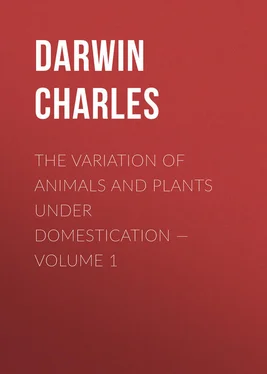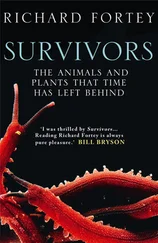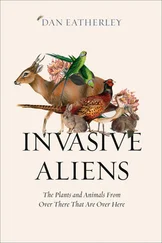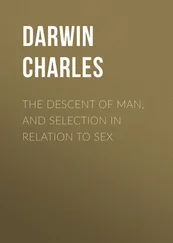Charles Darwin - The Variation of Animals and Plants under Domestication — Volume 1
Здесь есть возможность читать онлайн «Charles Darwin - The Variation of Animals and Plants under Domestication — Volume 1» — ознакомительный отрывок электронной книги совершенно бесплатно, а после прочтения отрывка купить полную версию. В некоторых случаях можно слушать аудио, скачать через торрент в формате fb2 и присутствует краткое содержание. Жанр: foreign_antique, foreign_prose, на английском языке. Описание произведения, (предисловие) а так же отзывы посетителей доступны на портале библиотеки ЛибКат.
- Название:The Variation of Animals and Plants under Domestication — Volume 1
- Автор:
- Жанр:
- Год:неизвестен
- ISBN:нет данных
- Рейтинг книги:5 / 5. Голосов: 1
-
Избранное:Добавить в избранное
- Отзывы:
-
Ваша оценка:
- 100
- 1
- 2
- 3
- 4
- 5
The Variation of Animals and Plants under Domestication — Volume 1: краткое содержание, описание и аннотация
Предлагаем к чтению аннотацию, описание, краткое содержание или предисловие (зависит от того, что написал сам автор книги «The Variation of Animals and Plants under Domestication — Volume 1»). Если вы не нашли необходимую информацию о книге — напишите в комментариях, мы постараемся отыскать её.
The Variation of Animals and Plants under Domestication — Volume 1 — читать онлайн ознакомительный отрывок
Ниже представлен текст книги, разбитый по страницам. Система сохранения места последней прочитанной страницы, позволяет с удобством читать онлайн бесплатно книгу «The Variation of Animals and Plants under Domestication — Volume 1», без необходимости каждый раз заново искать на чём Вы остановились. Поставьте закладку, и сможете в любой момент перейти на страницу, на которой закончили чтение.
Интервал:
Закладка:
The most interesting case which I have met with occurred in a colt of my own breeding. A bay mare (descended from a dark-brown Flemish mare by a light grey Turcoman horse) was put to Hercules, a thoroughbred dark bay, whose sire (Kingston) and dam were both bays. The colt ultimately turned out brown; but when only a fortnight old it was a dirty bay, shaded with mouse-grey, and in parts with a yellowish tint: it had only a trace of the spinal stripe, with a few obscure transverse bars on the legs; but almost the whole body was marked with very narrow dark stripes, in most parts so obscure as to be visible only in certain lights, like the stripes which may be seen on black kittens. These stripes were distinct on the hind-quarters, where they diverged from the spine, and pointed a little forwards; many of them as they diverged became a little branched, exactly in the same manner as in some zebrine species. The stripes were plainest on the forehead between the ears, where they formed a set of pointed arches, one under the other, decreasing in size downwards towards the muzzle; exactly similar marks may be seen on the forehead of the quagga and Burchell's zebra. When this foal was two or three months old all the stripes entirely disappeared. I have seen similar marks on the forehead of a fully grown, fallow-dun, cob-like horse, having a conspicuous spinal stripe, and with its front legs well barred.
In Norway the colour of the native horse or pony is dun, varying from almost cream-colour to dark-mouse dun; and an animal is not considered purely bred unless it has the spinal and leg-stripes. (2/34. I have received information, through the kindness of the Consul-General, Mr. J.R. Crowe, from Prof. Boeck, Rasck, and Esmarck, on the colours of the Norwegian ponies. See also 'The Field' 1861 page 431.) My son estimated that about a third of the ponies which he saw there had striped legs; he counted seven stripes on the fore-legs and two on the hind-legs of one pony; only a few of them exhibited traces of shoulder stripes; but I have heard of a cob imported from Norway which had the shoulder as well as the other stripes well developed. Colonel H. Smith (2/35. Col. Hamilton Smith 'Nat. Lib.' volume 12 page 275.) alludes to dun-horses with the spinal stripe in the Sierras of Spain; and the horses originally derived from Spain, in some parts of South America, are now duns. Sir W. Elliot informs me that he inspected a herd of 300 South American horses imported into Madras, and many of these had transverse stripes on the legs and short shoulder-stripes; the most strongly marked individual, of which a coloured drawing was sent me, was a mouse-dun, with the shoulder-stripes slightly forked.
In the North-Western parts of India striped horses of more than one breed are apparently commoner than in any other part of the world; and I have received information respecting them from several officers, especially from Colonel Poole, Colonel Curtis, Major Campbell, Brigadier St. John, and others. The Kattywar horses are often fifteen or sixteen hands in height, and are well but lightly built. They are of all colours, but the several kinds of duns prevail; and these are so generally striped, that a horse without stripes is not considered pure. Colonel Poole believes that all the duns have the spinal stripe, the leg-stripes are generally present, and he thinks that about half the horses have the shoulder-stripe; this stripe is sometimes double or treble on both shoulders. Colonel Poole has often seen stripes on the cheeks and sides of the nose. He has seen stripes on the grey and bay Kattywars when first foaled, but they soon faded away. I have received other accounts of cream-coloured, bay, brown, and grey Kattywar horses being striped. Eastward of India, the Shan (north of Burmah) ponies, as I am informed by Mr. Blyth, have spinal, leg, and shoulder stripes. Sir W. Elliot informs me that he saw two bay Pegu ponies with leg-stripes. Burmese and Javanese ponies are frequently dun-coloured, and have the three kinds of stripes, "in the same degree as in England." (2/36. Mr. G. Clark in 'Annal and Mag. of Nat. History' 2nd series volume 2 1848 page 363. Mr. Wallace informs me that he saw in Java a dun and clay-coloured horse with spinal and leg stripes.) Mr. Swinhoe informs me that he examined two light- dun ponies of two Chinese breeds, viz., those of Shanghai and Amoy; both had the spinal stripe, and the latter an indistinct shoulder-stripe.
We thus see that in all parts of the world breeds of the horse as different as possible, when of a dun-colour (including under this term a wide range of tint from cream to dusty black), and rarely when almost white tinged with yellow, grey, bay, and chestnut, have the several above-specified stripes. Horses which are of a yellow colour with white mane and tail, and which are sometimes called duns, I have never seen with stripes. (2/37. See also on this point 'The Field' July 27, 1861 page 91.)
From reasons which will be apparent in the chapter on Reversion, I have endeavoured, but with poor success, to discover whether duns, which are so much oftener striped than other coloured horses, are ever produced from the crossing of two horses, neither of which are duns. Most persons to whom I have applied believe that one parent must be dun; and it is generally asserted that, when this is the case, the dun-colour and the stripes are strongly inherited. (2/38. 'The Field' 1861 pages 431, 493, 545.) One case, however, has fallen under my own observation of a foal from a black mare by a bay horse, which when fully grown was a dark fallow-dun and had a narrow but plain spinal stripe. Hofacker (2/39. 'Ueber die Eigenschaften' etc. 1828 s. 13, 14.) gives two instances of mouse-duns (Mausrapp) being produced from two parents of different colours and neither duns.
The stripes of all kinds are generally plainer in the foal than in the adult horse, being commonly lost at the first shedding of the hair. (2/40. Von Nathusius 'Vortrage uber Viehzucht' 1872 135.) Colonel Poole believes that "the stripes in the Kattywar breed are plainest when the colt is first foaled; they then become less and less distinct till after the first coat is shed, when they come out as strongly as before; but certainly often fade away as the age of the horse increases." Two other accounts confirm this fading of the stripes in old horses in India. One writer, on the other hand, states that colts are often born without stripes, but that they appear as the colt grows older. Three authorities affirm that in Norway the stripes are less plain in the foal than in the adult. In the case described by me of the young foal which was narrowly striped over nearly all its body, there was no doubt about the early and complete disappearance of the stripes. Mr. W.W. Edwards examined for me twenty-two foals of race-horses, and twelve had the spinal stripe more or less plain; this fact, and some other accounts which I have received, lead me to believe that the spinal stripe often disappears in the English race-horse when old. With natural species, the young often exhibit characters which disappear at maturity.]
The stripes are variable in colour, but are always darker than the rest of the body. They do not by any means always coexist on the different parts of the body: the legs may be striped without any shoulder-stripe, or the converse case, which is rarer, may occur; but I have never heard of either shoulder or leg-stripes without the spinal stripe. The latter is by far the commonest of all the stripes, as might have been expected, as it characterises the other seven or eight species of the genus. It is remarkable that so trifling a character as the shoulder-stripe being double or triple should occur in such different breeds as Welch and Devonshire ponies, the Shan pony, heavy cart-horses, light South American horses, and the lanky Kattywar breed. Colonel Hamilton Smith believes that one of his five supposed primitive stocks was dun-coloured and striped; and that the stripes in all the other breeds result from ancient crosses with this one primitive dun; but it is extremely improbable that different breeds living in such distant quarters of the world should all have been crossed with any one aboriginally distinct stock. Nor have we any reason to believe that the effects of a cross at a very remote period would be propagated for so many generations as is implied on this view.
Читать дальшеИнтервал:
Закладка:
Похожие книги на «The Variation of Animals and Plants under Domestication — Volume 1»
Представляем Вашему вниманию похожие книги на «The Variation of Animals and Plants under Domestication — Volume 1» списком для выбора. Мы отобрали схожую по названию и смыслу литературу в надежде предоставить читателям больше вариантов отыскать новые, интересные, ещё непрочитанные произведения.
Обсуждение, отзывы о книге «The Variation of Animals and Plants under Domestication — Volume 1» и просто собственные мнения читателей. Оставьте ваши комментарии, напишите, что Вы думаете о произведении, его смысле или главных героях. Укажите что конкретно понравилось, а что нет, и почему Вы так считаете.












